Quetzals, bellbirds and zip-lining
Santa Elena
The town is small, and the roadsides dusty. It has all the amenities you need; a couple of ATMs, a bank, two supermarkets, some tourist shops and a few decent restaurants. Without anything planned that morning we did all our Costa Rica tourist shopping; buying that towel with the sloth money on it, buying a sloth cuddly toy, buying hats that said “Pura Vida”, you know, all the cheesy stuff we were pleased to get carried away with.
Sky Adventures
A minibus picked us up at 1pm, my first outing since my unfortunate illness. Our pre-booked tour was a hike at the Sky Adventures park, a “Sky walk” around the hanging bridges, high up in the cloud forest.
Just a 10 minute drive from our hotel, the weather was much cooler, clear skies changed to thick cloud, and our sandals, t-shirt and shorts were now leaving us a little chilly; we were smart enough to pack some wet weathers.
By pure serendipity we bumped into the Dutch couple we had lunch with in Cahuita; Caroline and Clement; they were on the same tour as us, at the same time, and they’d booked it themselves. Since we’d seen them last they’d been to Sarapiqui and La Fortuna, driving themselves here over those crazy roads.
Sky walk
In a group of about 10, with our guide Andre, we headed for the sky bridges. Everything is named “sky” something here, “we are literally in the cloud”, Andre says. The walk was a fairly leisurely hour and a half across 5 hanging bridges, and Andre would stop and point out interesting plants, bird songs and insects as we walked around. We were lucky with our bird sightings.
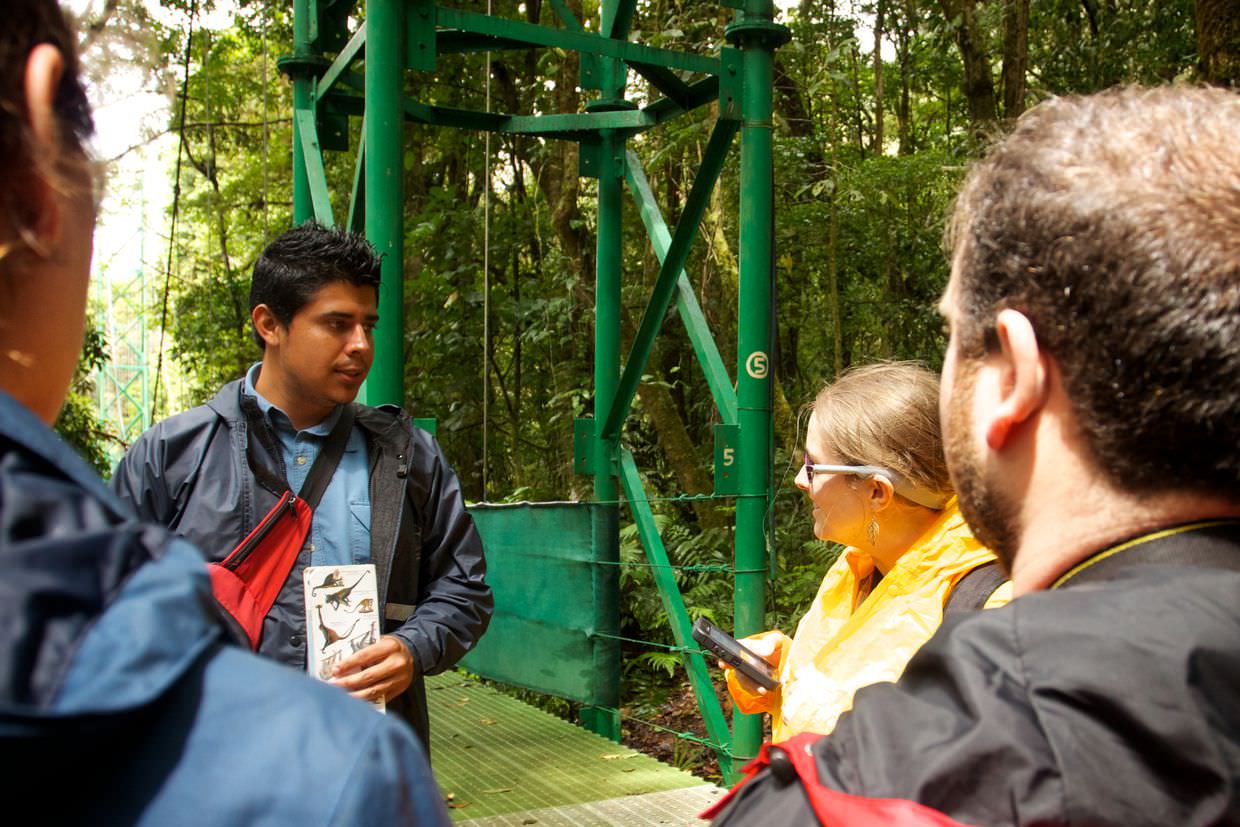
Andre started with “busy lizzy”, a flower who’s roots have medicinal benefits; you can boil them and use them to treat haemorrhoids, apparently. We learnt about the monkey species in Costa Rica, there are 4 – squirrel, spider, howler and white-faced. And then about the national bird, the clay-coloured thrush, or yigüirro, not especially beautiful, but its song is gorgeous, and is usually heard around the beginning of the rainy season, “if it’s making a noise, the rain is coming”. Sam remained ever inquisitive, and her questions tested the limits of our guide’s knowledge; a theme throughout this trip.
Each of the hanging bridges is long, suspended and green. Not too many are allowed on at a time, and as you walk it sways side to side. It’s best to hold on to the edge as you look down into the treetops far below. As we crossed there was a noise, not unlike a rusty swing – like metal rubbing against metal, like the bridge wasn’t happy with our weight, somewhat disconcerting. “Oh no, that’s a bird song”, Andre explained. What we were hearing was the most curious song by the black-faced solitaire bird – it’s worth listening to, and this video by Robert Howe demonstrates it well. It’s similar too to the Mockingjay noise used in the Hunger Games. I feel a childlike awe when I discover things like this, like we’re in some sort of fantasy world.

Quetzals
From the first hanging bridge we looked down at an Aguacatillo tree, a relation of the avocado and part of the Persea family, we could see its fruit – like tiny wild avocados, they looked a lot like acorns. These are the favourite food of Costa Rica’s most infamous bird, the resplendent quetzal. This is the bird that birders flock to Monteverde to see; the male’s have a beautiful iridescent green body, a red breast, a helmet crest, and two long tail feathers; if you see one, you’re lucky.
It’s about now that Andre hears their birdsong, and we all rush along to the end of the hanging bridge. There we find a pair, a green female quetzal is perched on an old tree trunk busily preparing a nest, while the male sits idle on a furry branch nearby, its tail feathers hanging down below; as if to treat us, it flies a little closer. Its position was perfect, and with our 400mm lens it was perfectly framed – but taking a picture with a long telephoto lens on a moving hanging bridge, where every movement makes it sway a little, is devilishly hard.
We could have stayed there all day, watching these magical green birds preparing to start a family.
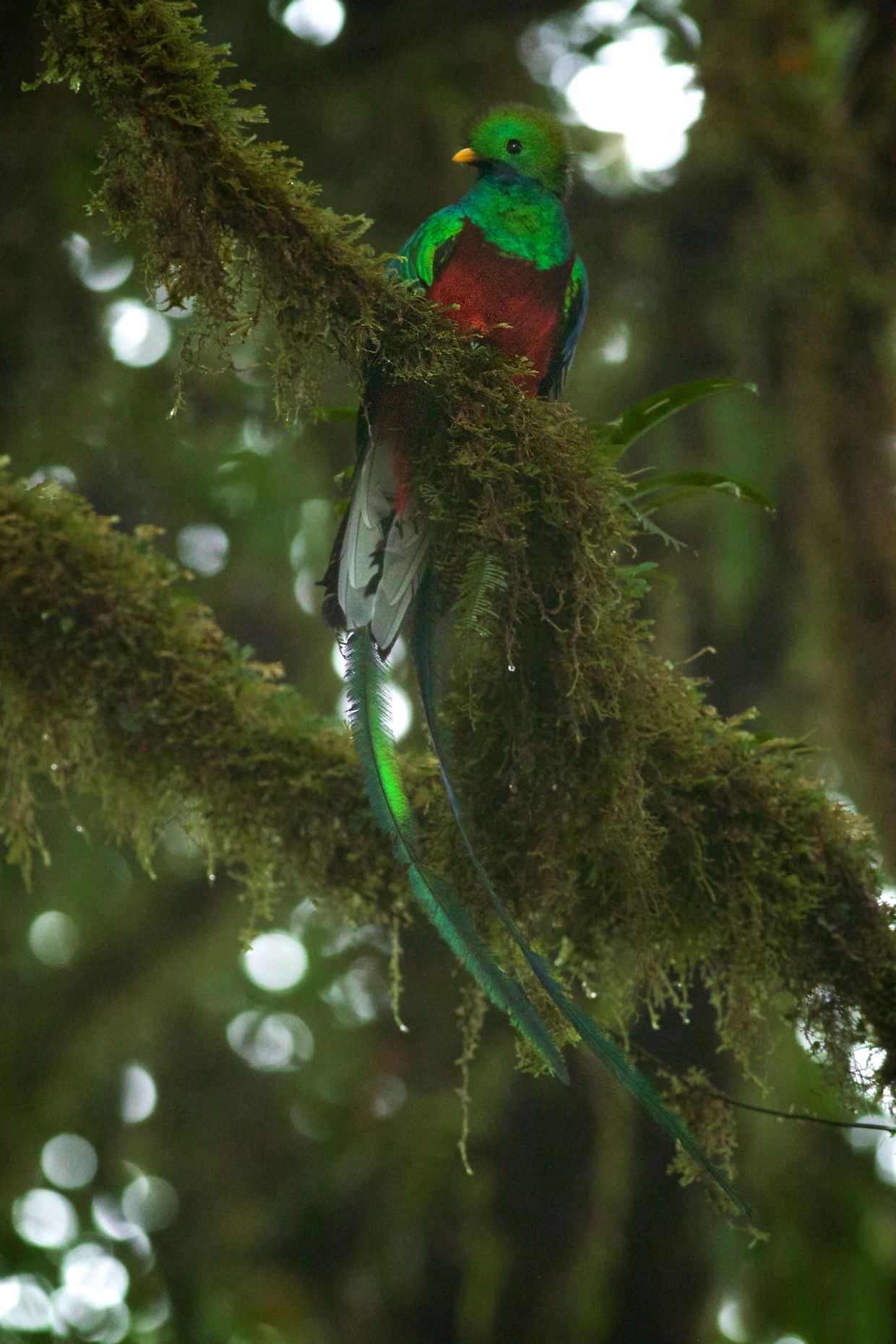
Three-wattled bellbird
Here’s where this tour gets crazy lucky. The second bird on many birder’s lists is the threatened three-wattled bellbird. The male has a chocolate brown body and a white head, but peculiarly from its bill hang three black worm-like wattles, one from each side and one from the top. The bird is enigmatic and hard to spot, its presence usually noted only by its distinctive birdsong, another metal sound, like a bell, or an alarm, or a chair scraping against the floor.
On the second hanging bridge we could hear its song, and Andre scanned the cloudy horizon looking for it in the treetops. And there it was, at the top of a sparse tree, screeching occasionally, its wattles dangling oddly. Here’s someone else’s video of a different bellbird singing its song.
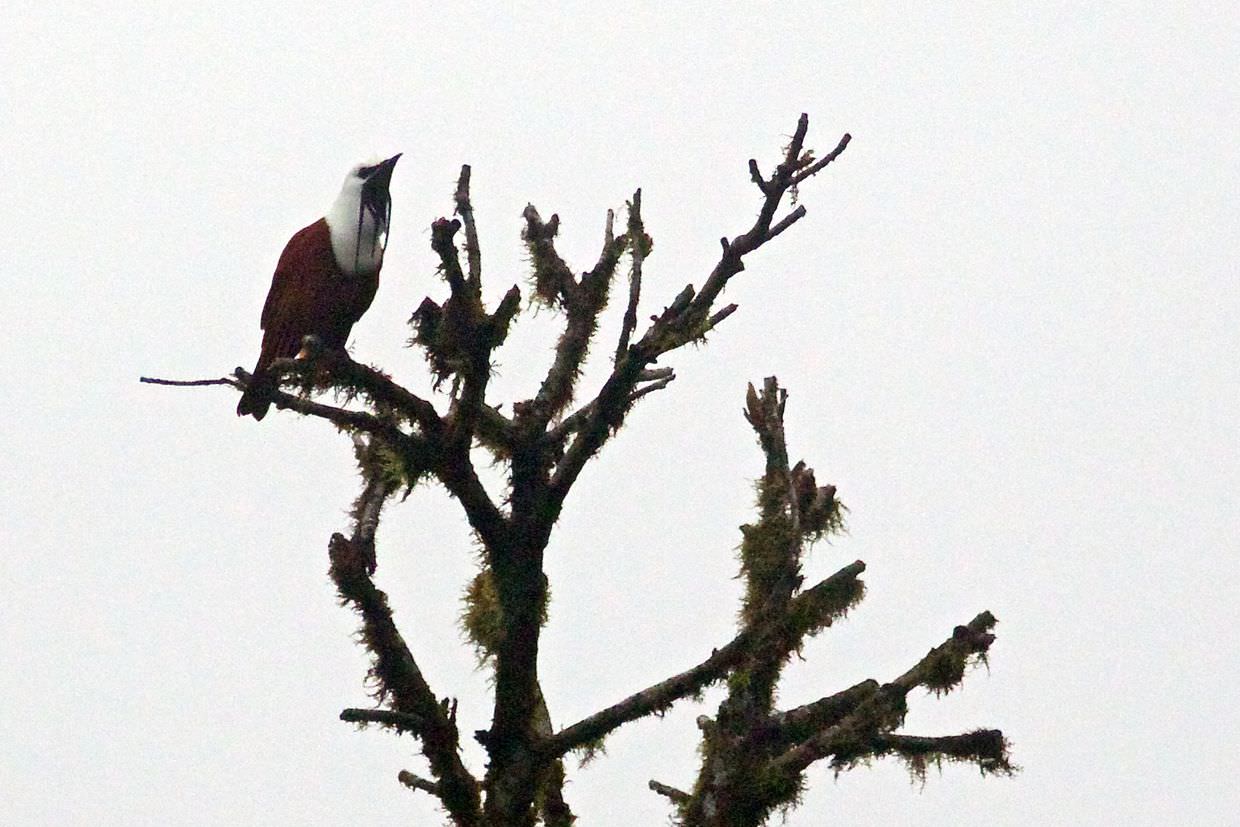
“We need to see a Trogon to complete the set”, Andre said, excitedly.
Remainder of the hike
The rest of the hike wasn’t quite so exciting, but interesting nonetheless – back to our scheduled programming. Andre showed us a wild ginger plant, the roots are edible and the leaves are silky smooth, sleeping in a bed of these leaves must be a wonderful thing. We learnt about the cloud forest ecosystem, the towering ancient fern trees that grow 5-10m per year, and the trumpet tree (or cecropia), with its hollow trunk and its leaves which can be used to alleviate asthma and other ailments – and which are loved by sloths. The yellow rattlesnake plant has yellow flowers that look uncannily like a rattlesnake’s tail. Their pods store water. Then there was a wild citronella berry, that smelt like the most refreshing and tasty citrus fruit imaginable, but the berry isn’t edible. Not to mention the strangling figs that devour trees whole, or the epiphytes, the plants that harmoniously live on other plants, like orchids.
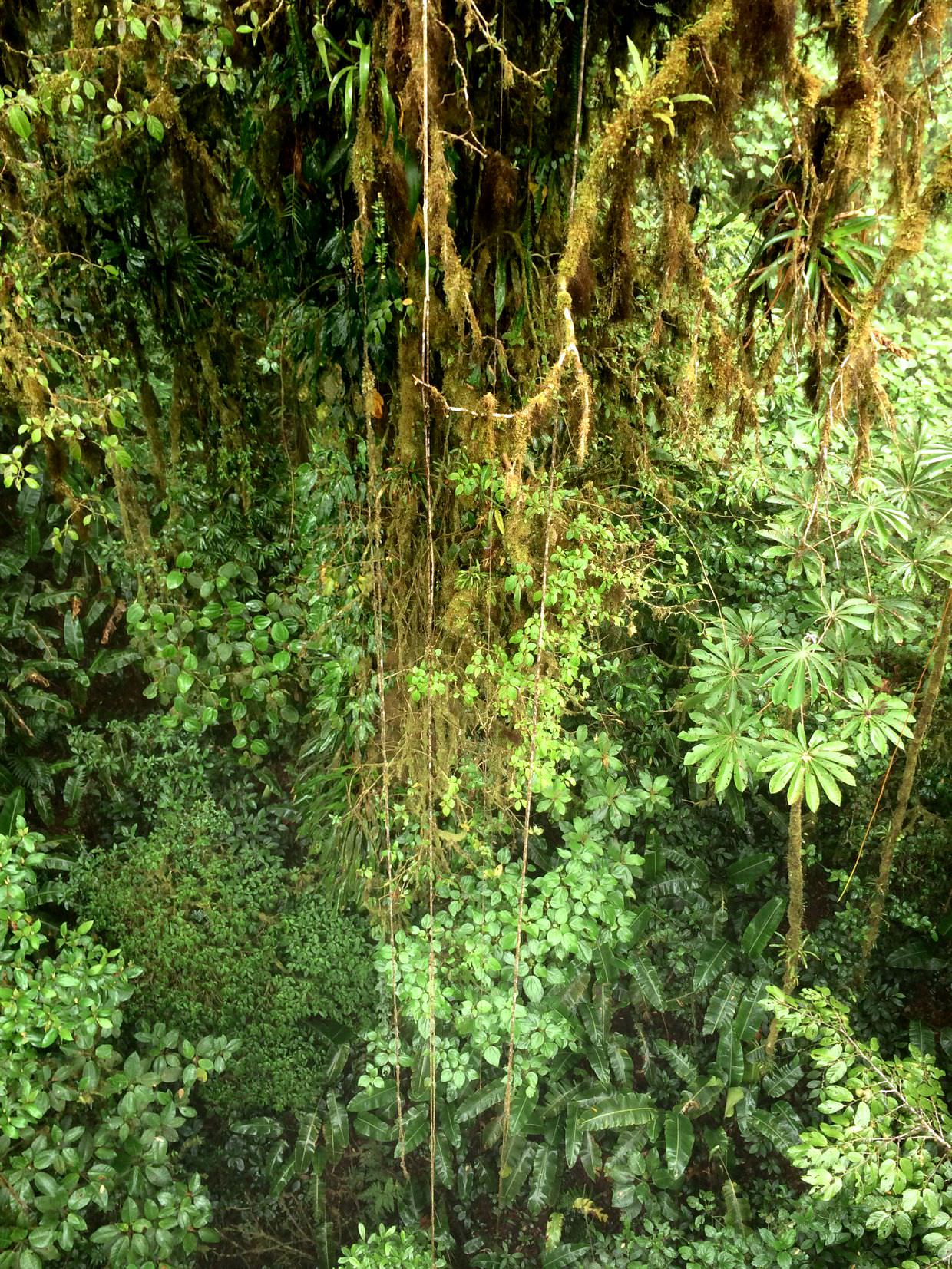
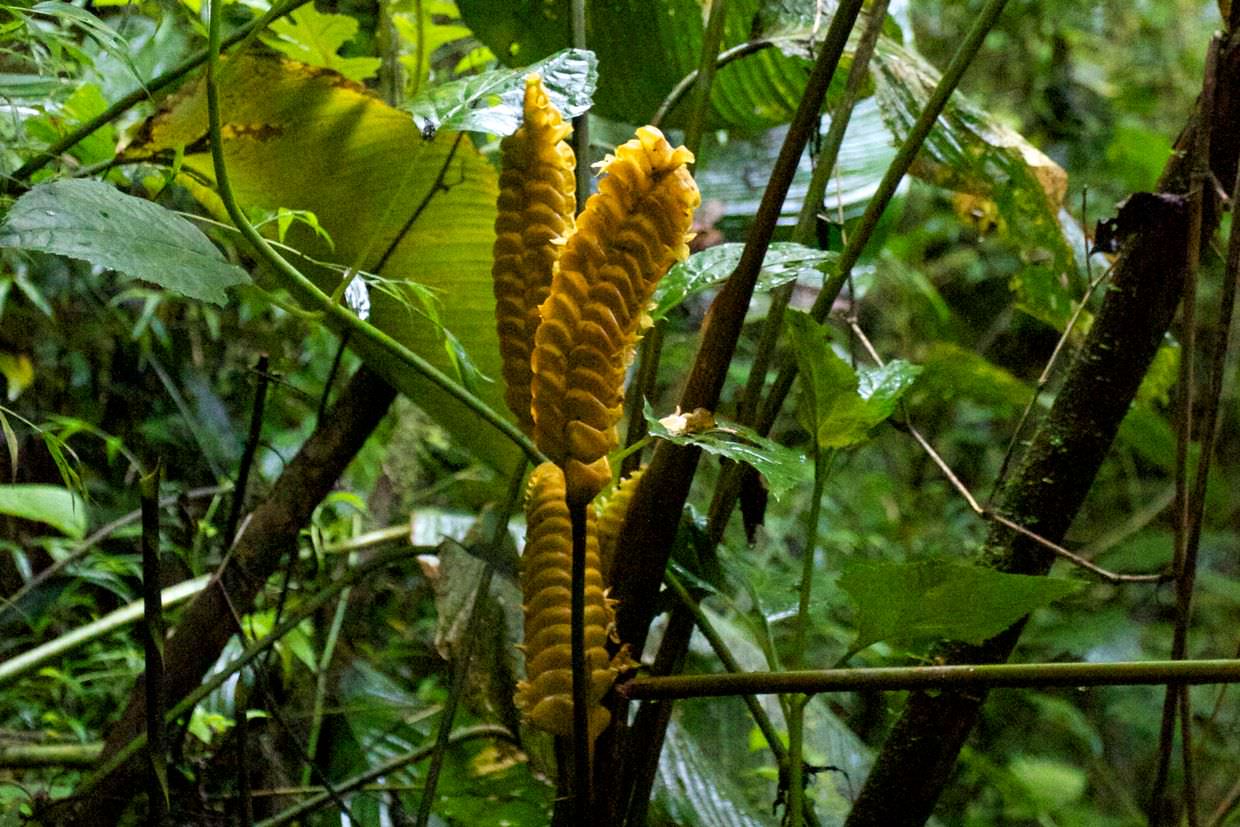
On the floor we had to be careful not to step on any millipedes, we saw the yellow striped python millipede, which would regularly walk out in front of us, and the yellow spotted millipede which, when bothered, can secrete a substance that contains small amounts of cyanide.
While Andre showed us the last plant on his tour, the poor man’s umbrella (or Gunnera) – one of the largest leaves in Costa Rica, with a texture like sandpaper, we had another bird sighting. A blue-throated mountaingem hummingbird paid us a brief visit, before flying away again into the foliage. That was the end of the hike, and we would now exchange the sounds of crickets, cicadas and birds-making-metalwork-noises for a thrilling zip-wire adventure.
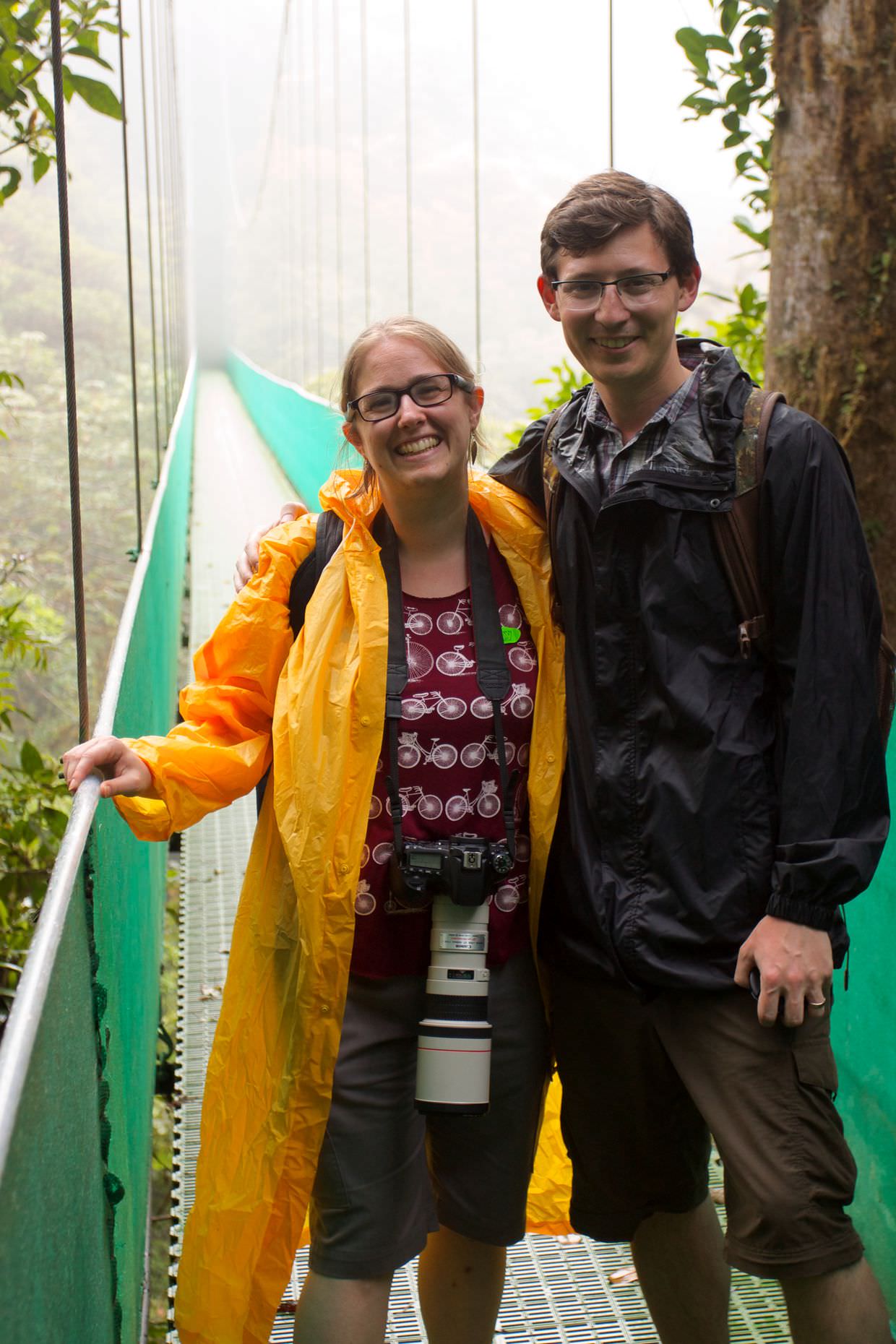
Sky Trek zip wire
I opted out of the zip wire, my digestive system wasn’t quite ready to fly through the air just yet. But Samantha, a woman who is normally afraid of heights and a person you’d be hard pressed to get on a roller coaster, leaped at the chance. She joined Caroline and Clement, while I photographed them. After a short practice run we all took the “Sky Tram”, a short cable car ride, up to the top of the cloud forest. “How often is it clear here?”, “One, maybe two days a year”.
You clip yourself onto the zip-wire and hold on tight with both hands, before pushing-off and flying away, disappearing into the clouds. I took the tram back down and waited for them all to re-materialise out of the mist.


Pizza
Our Dutch friends drove us into town, and before our night tour together we grabbed pizza from Bon Appetit.
Costa Rican pineapple tastes delicious, so I ordered a Hawaiian. On the menu it said, “Ham, pineapple and cherry”. Cherry tomatoes, surely, it must be a poor translation. Nope – glacier cherries, rich sugary red cherries on a pizza. Imagine a pizza that has the slight taste of bakewell tart. Yeugh.

Santa Maria night walk
Andre recommended us a nearby night walk, run by “Santamaria finca” (TripAdvisor), finca means farm. We checked out the place before dinner, and it looked quiet, but when we returned it was heaving with minibuses and tour groups. At least 100 people were going out into the nearby woods, in groups of 10, looking for nocturnal wildlife. We’re here, it’s almost 6pm, we’ll go too.
Our guide was Luis, he worked the night tours part time and wasn’t a “fully trained guide”. On a night tour where I’d expect to keep quiet and hope some wild animal might wander by, he shouted to us. A noisy fella, but with a 100 people trampling around, shining torches everywhere, it probably had no effect. We wouldn’t see anything but the obvious, the creatures that don’t move much, or the ones the guides can reliably point out. (We had a much better night tour in Manuel Antonio).
In the trees near the entrance we saw a blue-crowned motmot, and on a nearby tree a scorpion scuttled up and away, afraid of the light. At this point I was a little concerned about my open-toed sandals. Ah well, nevermind.
Along a gravel road we stopped by a burrow in the muddy bank; here you’re almost guaranteed to see a large female orange-kneed tarantula – the classic tarantula. They live in these holes, while the males wander about the trees looking for a mate. They rarely bite, but when they do it can hurt but it’s certainly not deadly. They use the hairs (or “urticating bristles”) on their abdomen as a more common defence, which they fire at predators, like coatis, to protect themselves from being eaten.
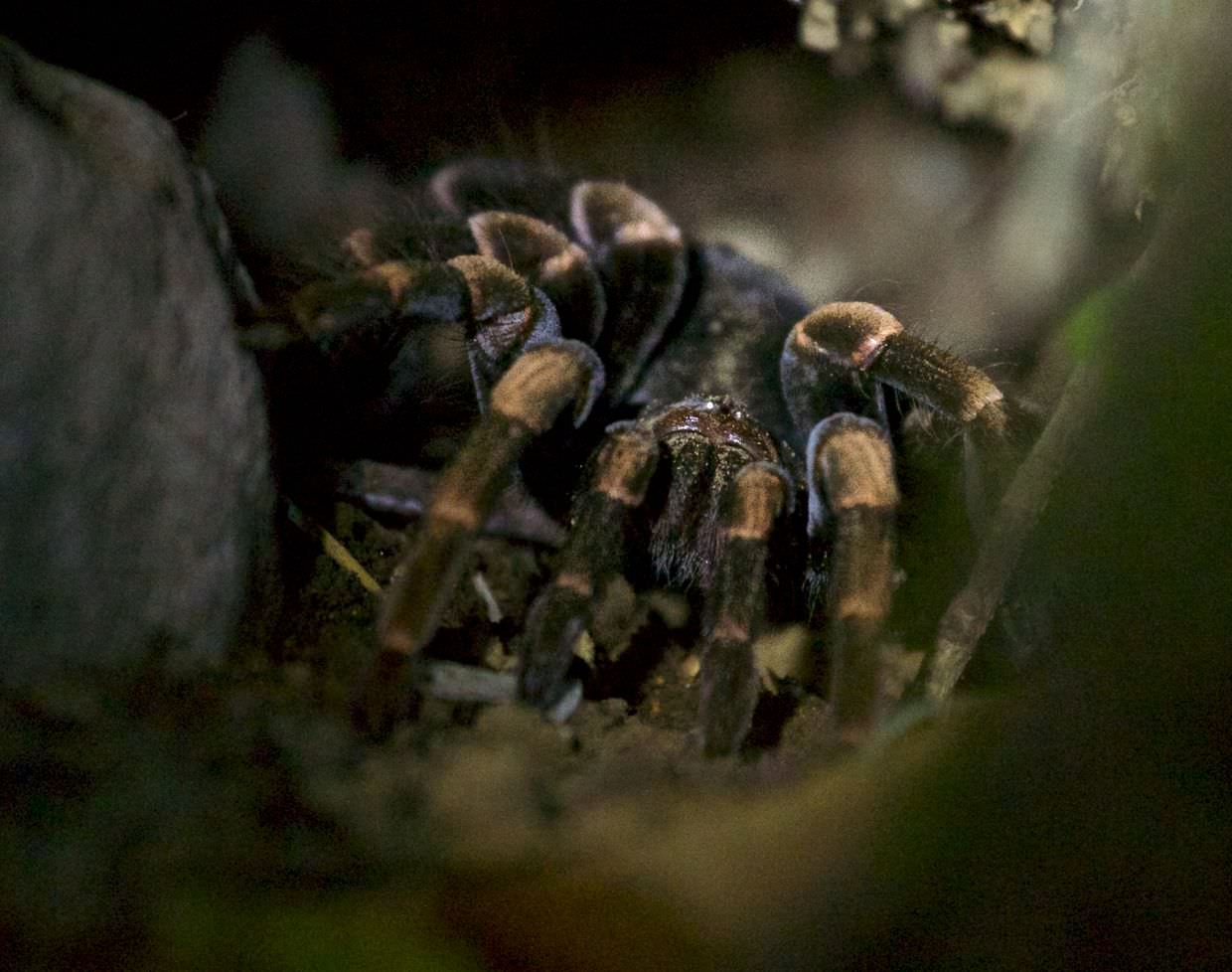
Our next spotting was more deadly, the side-striped pit viper. About a metre long, and wrapped around a branch above our heads, Luis said a bite would kill you in 2 hours, and that they have a tendency to attack anything that might threaten them; I think this was a bit of showmanship on his part. Bites aren’t quite so deadly, they’re serious, but deaths are rare, and they prefer not to move unless touched, when there action is swift and immediate.
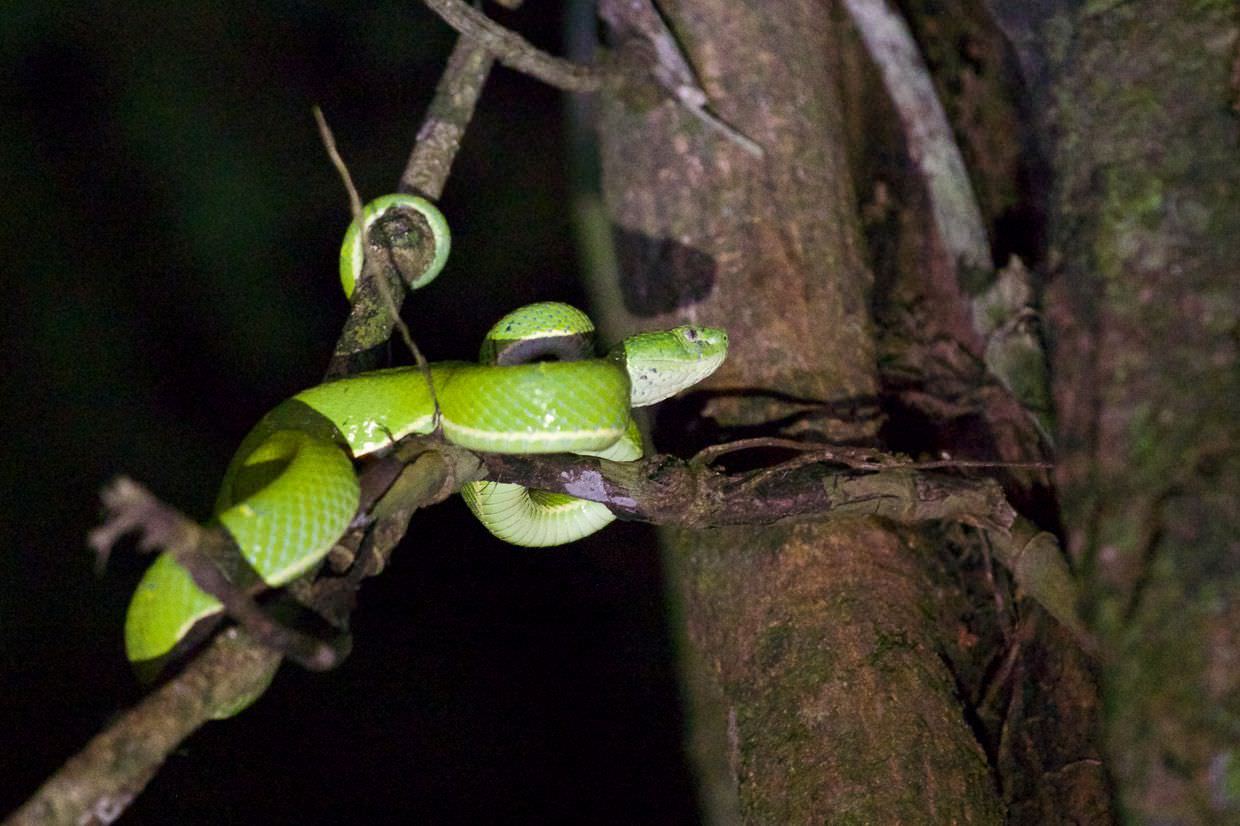
While tromping through the dark forest in single file I spotted two little lights moving around in the grass. It was a click click beetle, and on its back are two yellow bioluminescent lights that make it look like a tiny flying car with its headlights on. The beetle also makes a slight clicking noise.
There was also a sleeping sloth, high in a tree. All the groups came out to see it on the roadside, but it was high, it wasn’t moving, and it was dark, so you couldn’t see much – probably the worst sloth sighting we had. We saw a sleeping grey hawk in a tree, on the ground a trail of leaf cutter ants hard at work, and resting, spread out along a branch, a giant anole lizard.
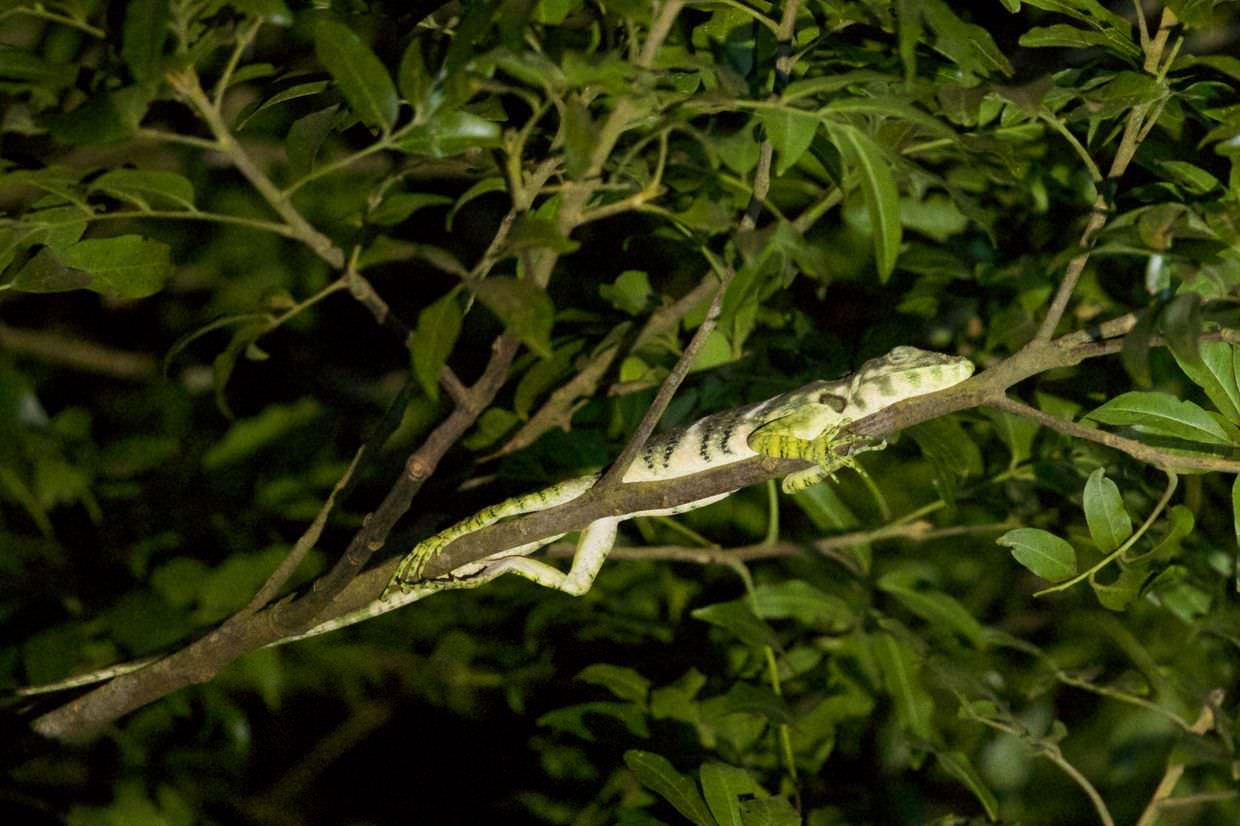
Luis walked us back, and told stories about the time he saw an Ocelot chasing a squirrel. Caroline and Clement dropped us back at our hotel in their 4x4 and we said our farewells, we wouldn’t bump into them again – they were leaving tomorrow, and we wished them luck on the dusty difficult roads ahead.